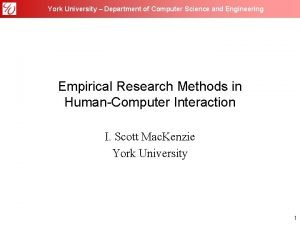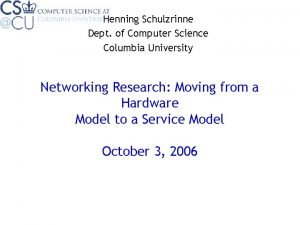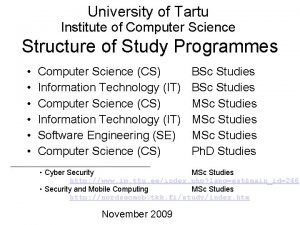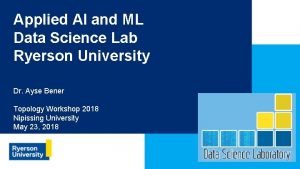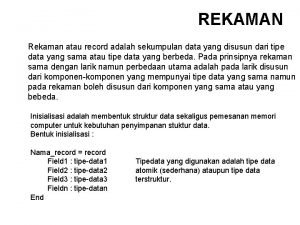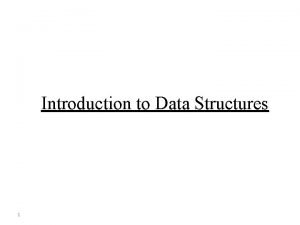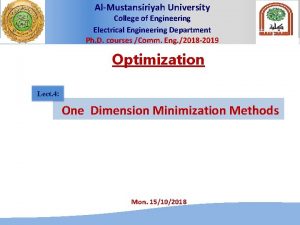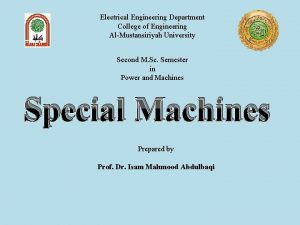DATA STRUCTURE AlMustansiriyah University College of Science Computer












![EXAMPLE If we have array declared as : int [] a = new int EXAMPLE If we have array declared as : int [] a = new int](https://slidetodoc.com/presentation_image_h/26974278243d8508f1f598f03d15144b/image-13.jpg)


![EXAMPLE If we have array declared as : int [, ] a = new EXAMPLE If we have array declared as : int [, ] a = new](https://slidetodoc.com/presentation_image_h/26974278243d8508f1f598f03d15144b/image-16.jpg)

















- Slides: 33

DATA STRUCTURE Al-Mustansiriyah University College of Science Computer Department Dr. Ghassan M. Al-Saddi

INDEX Ø Introduction Ø Arrays - One Dimensional - Two Dimensional - Multi-Dimensional Ø Algorithm Analysis (Complexity) Ø Stack Ø Queue Ø Tree Ø List - Array List - Linked List

INTRODUCTION Data structure (collections) A collection of data elements whose organization is characterized by accessing operations that are used to store and retrieve the individual elements. Algorithm It is a finite set of instructions that, if followed, accomplish a particular task. In our course, it is not enough to specify the form of data structure, but we must give also the algorithm of operation to access these data structures. Any algorithm must satisfy the following criteria :

INTRODUCTION Algorithm Input Definiteness Output Finiteness Effectiveness

INTRODUCTION The Data structure is a systematic way to organize data in order to use it efficiently. The following terms are foundation terms of a data structure. Ø Interface : Each data structure has an interface. The nnterface represents the set of operations that a data structure supports. An interface only provides the list of supported operations, types of parameters they can accept and return type of these operations. Ø Implementation : The implementation provides the internal representation of a data structure. Implementation also provides the definition of the algorithms used in the operations of the data structure.

NEED FOR DATA STRUCTURE As applications are getting complex and data-rich, there are three common problems applications face nowadays. Data Search Multiple Requests Processor Speed

NEED FOR DATA STRUCTURE To solve the above problems, data structures come to rescue. Data can be organized in a data structure in such a way that all items may not be required to be searched and the required data can be searched almost instantly.

SUITABLE DATA STRUCTURE For each set of data, there are different methods to organize this data in a particular data structure. To choose a suitable data structure, we must use the following criteria : Ø Ø Data size Required memory Dynamic nature of the data The required time to obtain any data element from the data structure. Ø The programming approach Ø The algorithm will be used to manipulate these.

Programming language usually provides some data structures that are built into the language, for instance, C, C++, and C# provide structures and arrays of various dimensions.

ARRAYS IN C# Ø The array is the most common data structure, present in nearly all programming languages. Ø Using an array in C# involves creating an array object of system array type, the abstract base type for all arrays. Ø The array is a container that can hold fix number of items and these items should be of the same type. Ø Each item stored in an array is called an element. Ø Each location of an element in an array has a numerical index that is used to identify the element. Ø The Array class provides a set of methods for performing tasks such as sorting and searching that programmers had to build by hand in the past. Ø Arrays are indexed collections of data. The data can be of either a built-in type or a user-defined type. Ø In fact, it is probably the simplest just to say that array data are objects. Arrays in C# have actually objected themselves because they derive from the system array class.

ONE DIMENSIONAL ARRAYS A one-dimensional array can be implemented easily the C# declaration: int [] a = new int [10]; index data a

ONE DIMENSIONAL ARRAYS Ø Reserves 10 successive memory locations, Ø Each location large enough to Conation single integer. Ø The address of the first location is called the base address of the array a and is denoted by base (a). Explanation Suppose that the Size of each individual element of the array is esize. Then reference to the element a[0] is to the element at location base(a), reference to a[1] is to the element at base (a) + 1*esize , reference to a[2] is the element base (b) +2*esize. In general, the reference to a [i] is to the element location base (a) +i*esize.
![EXAMPLE If we have array declared as int a new int EXAMPLE If we have array declared as : int [] a = new int](https://slidetodoc.com/presentation_image_h/26974278243d8508f1f598f03d15144b/image-13.jpg)
EXAMPLE If we have array declared as : int [] a = new int [10]; So the address of a [0] is base (a) , let us suppose that each element of the array requires a single unit of storage , so esize = 1 Then the location of a [i] can be computed by : address of a[i] = base [a] + i *esize suppose base (a) =500 location of a[2] =500 + 2*1 =502

TWO DIMENSIONAL ARRAYS A two-dimensional array can be implemented easily the C# declaration: int [, ] a = new int [3, 4]; Ø An element of a two-dimensional array is accessed by specifying two indices: a raw number and column number. Ø The number of rows or Columns is called the range of the dimension. As array must be stored in the memory of a computer, and the memory is usually linear.

TWO DIMENSIONAL ARRAYS Let us suppose that, for an array are, base (a) is the address of the first element of the array. That is, if a is declared by int [, ] a = new int [M, N]; Where M and N are the range of the first and the second dimension, base (a) is the address of a[0, 0]. We also assume that esize is the size of each element in the array. Let us calculate the address of an arbitrary element a[i, j] the address of a[i, j] = base (a) + (N * i +j)*esize // Row wise method the address of a[i, j]=base(a) + (M*j +i)*esize//Column wise method
![EXAMPLE If we have array declared as int a new EXAMPLE If we have array declared as : int [, ] a = new](https://slidetodoc.com/presentation_image_h/26974278243d8508f1f598f03d15144b/image-16.jpg)
EXAMPLE If we have array declared as : int [, ] a = new int [M, N]; So , M= 3 and N =4 and the address of a [0, 0] is base (a) , let us suppose that each element of the array requires a single unit of storage , so seize = 1 Then the location of a [2, 1] can be computed using by row wise method: suppose base(a) = 500 location (a[2, 1] ) = base [a] + (N*i+j) *esize = 500 + (4*2+1) *1 = 509

MULTI-DIMENSIONAL ARRAYS C# also allows arrays with more than two-dimension, for example, a three-dimensional array int [, , ] a= new int [M, N, R]; the address of a[i, j, k] = base (a) + (M*N * k +N*i+j)*esize. // Row wise method the address of a[i, j, k] = base (a) + (M*N*k +M*j+i)*esize. // Column wise method Example , a four dimensional array int [ , , , ] a= new int [M, N, R, P]; the address of a[i, j, k, l]= base (a) + (M*N *R * l +M*N*k +N*i+j)*esize // Row wise method the address of a[i, j, k, l]=base(a)+(M*N*R*l+ M*N*k +M*j+i)*esize // Column wise method

DATA STRUCTURE CLASSIFICATION Implementation of Data Structure into Computer Memory Static (Array Based) Dynamic (Pointer (Linked Based))

DATA STRUCTURE CLASSIFICATION Arrays A sequence of n items of the same data type that are stored contiguously in computer memory and made accessible by specifying a value of the array’s index. Linked List ØA sequence of zero or more nodes each containing two kinds of information: some data and one or more links called pointers to other nodes of the linked list. ØSingly linked list (next pointer) ØDoubly linked list (next + previous pointer)

DATA STRUCTURE TYPES Type of Data Structure Linear Structure Non-Linked Structure (Stack, Queue, Circular Queue, List) Linked Structure (Linked Stack, Linked Queue, Linked List) Non-Linear Structure Directed Graph (Tree Structure) Undirected Graph

ALGORITHM ANALYSIS (BIG O) Complexity : In examining algorithm efficiency we must understand the idea of complexity Complexity Space Complexity * When memory was expensive we focused on making programs as space efficient as possible and developed schemes to make memory appear larger than it really was (virtual memory and memory paging schemes). * Space complexity is still important in the field of embedded computing (handheld computer-based equipment like cell phones, palm devices, etc). Time Complexity * Is the algorithm “fast enough” for my needs * How much longer will the algorithm take if I increase the amount of data it must process * Given a set of algorithms that accomplish the same thing, which is the right one

BIG OH (ASYMPTOTIC ANALYSIS) ØAssociates n ØThe problem size with t ØThe processing time required to solve the problem

EXECUTION TIME CASES There are three cases which are usually used to compare various data structure’s execution time in a relative manner Worst executing the algorithm produces a path Case lengths that are always a maximum. Average Case executing the algorithm produces path lengths that will on average be the same. Best Case if the algorithm is executed, the fewest number of instructions are executed.

Frequency Count Ø Examine a piece of code and predict the number of instructions to be executed. Ø e. g. for each instruction predict how many times each will be encountered as the code. inst Code F. C. 1 for (int i=0; i< n ; i++) n+1 { 2 s = s + i; __n__ } 2 n+1

Ø In the previous example: Best-case = avg-case = worst-case Ø To convert F. C. to order of magnitude: v discard constant terms v disregard coefficients v pick the most significant term Ø Worst case path through an algorithm v order of magnitude will be Big O (i. e. O(n))

EXAMPLE Inst Code F. C 1 for (int i=0; i< n ; i++) n+1 2 for (int j=0 ; j < n; j++) n(n+1) n 2+n { 3 p = p + i *j ; n*n n 2 } 2 n 2+2 n+1 Ø Discarding constant terms produces : 2 n 2+2 n Ø Clearing coefficients : n 2+n Ø Picking the most significant term: n 2 Big O = O(n 2)

POWER FUNCTION EXAMPLE double Iter. Pow (double X, int N) { double Result = 1; 1 while (N > 0) { n+1 Result *= X; n N--; n } return Result; 1__ } Total instruction count: 3 n+3 algorithm's computing time (t) as a function of n is: 3 n + 3 t is on the order of f(n) - O[f(n)] O[3 n + 3] is n

COMMON GROWTH RATES constant O(1) logarithmic O(log 2 n) linear O(N) n log n O(n log 2 n) quadratic O(n 2) cubic O(n 3) exponential 2 O(n) polynomial n. O(1)

ABSTRACT DATA TYPE (ADT) Ø A definition for a data type solely in terms of a set of values and a set of operations on that data type. Ø Each ADT operation is defined by its inputs and outputs. Each operation associated with the ADT is implemented by one or more subroutines in the implementation

EXAMPLE Design abstract data type to find the area of Circle? 1 -Design Circle - radius: double + Circle (double) + Area(): double ADT : Circle { Data: a non zero positive real number representing the radius Operations: A constructor( Circle ) : initialize the data to some (default) Data object certain value. Area : Input: radius Process : compute the area of a circle using the following rule: Area= radius 2*π Output: the area of circle

EXAMPLE Design abstract data type to read two integer numbers and find the largest number 1 -Design Max. Number - number 1: int -number 2: int + Max. Number (int, int) + Find. Max (): integer ADT : Max. Number { Data: two integer numbers representing number 1 and number 2 Operations: A constructor( Max. Number ) : initialize the data to some (default) Data object certain value. Find. Max : Input: two numbers Process : find the maximum number : If number 1 > number 2 then return number 1 else return number 2 Output: the maximum number End ADT Max. Number

EXAMPLE Design abstract data type to create array table of 9 integer numbers , and search the value element in array and print index of numbers? Search 1 1 -Design - table: int[] -element: int ADT : Search 1 -size: int { + Search 1 (int, int) Data: create array table of 9 integer numbers + Read. Arr(): void Operations: +searchele(): void A constructor( Search 1 ) : initialize the data to some (default) Data object certain value. Search 1 : Input: array table of 9 integer numbers and value element. Process : search the value element in array and print index of numbers Output: index of search number or print not found End ADT Search 1

HOME WORK By using ADT 1 Design abstract data type to create an array table of 9 real numbers, and insert element in the array. 2 - Design abstract data type to create an array table of 9 real numbers , and delete the element In the array. 3 -Design abstract data type to create an array table of 9 real numbers, and sort element in an array ?
 沈榮麟
沈榮麟 Salahaddin university college of science
Salahaddin university college of science Ucf computer engineering
Ucf computer engineering Cst algonquin
Cst algonquin Manimoy paul
Manimoy paul Bryn mawr computer science
Bryn mawr computer science Stack is a static data structure
Stack is a static data structure As a child which subjects of science was your favourite
As a child which subjects of science was your favourite University of phoenix computer science
University of phoenix computer science Bridgeport engineering department
Bridgeport engineering department University of bridgeport computer engineering
University of bridgeport computer engineering Computer science yonsei university
Computer science yonsei university Fsu computer science department
Fsu computer science department York university computer science
York university computer science Unc chapel hill cs
Unc chapel hill cs Ucl ridgmount practice
Ucl ridgmount practice Seoul national university computer science
Seoul national university computer science Osaka university computer science
Osaka university computer science Computer science columbia university
Computer science columbia university Towson university computer science
Towson university computer science Kstate computer science
Kstate computer science Brown university computer science faculty
Brown university computer science faculty Trinity university computer science
Trinity university computer science Brandeis university cs
Brandeis university cs University of tartu institute of computer science
University of tartu institute of computer science Kotebe metropolitan university computer science
Kotebe metropolitan university computer science Mice.cs.columbia
Mice.cs.columbia Ryerson university data science
Ryerson university data science Basic structure of computer in computer organization
Basic structure of computer in computer organization Data representation computer science
Data representation computer science Record adalah
Record adalah Wake tech admissions
Wake tech admissions Early college high school at midland college
Early college high school at midland college Data structure operations
Data structure operations













